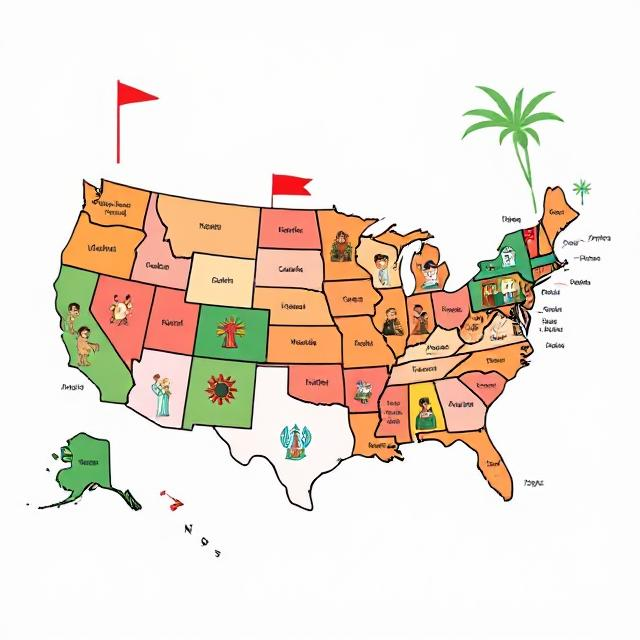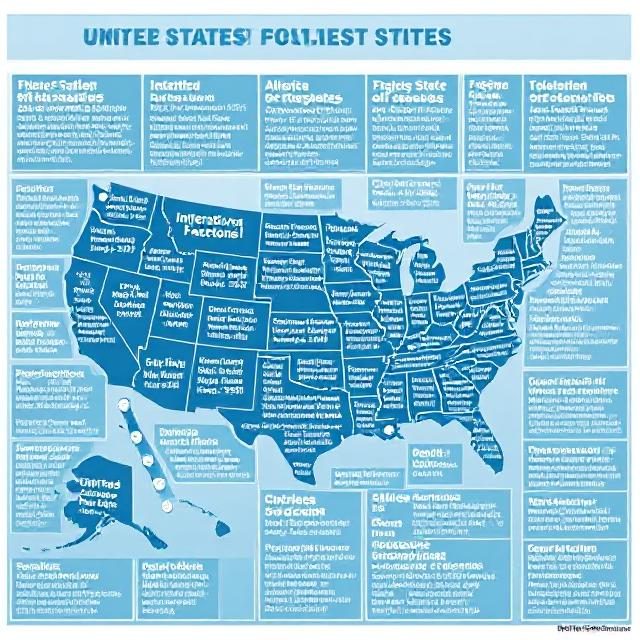The United States is a nation built on a complex interplay of historical, cultural, economic, and political factors. These elements have influenced its development, identity, and role in the world. This article explores the key factors that have shaped the United States, providing insights into its evolution from a collection of colonies to a global superpower.
Historical Factors

Colonization and Settlement
The colonization of North America began in the early 17th century, with European powers such as Spain, France, and England establishing settlements. The motivations for colonization included the pursuit of wealth, religious freedom, and the expansion of empires.
The Thirteen Colonies
The establishment of the thirteen British colonies along the Atlantic coast laid the foundation for the United States. Each colony developed distinct social, economic, and political systems, influenced by geography and cultural backgrounds.
New England Colonies: Known for shipbuilding, fishing, and trade, these colonies had a Puritan influence that shaped their social norms.
Middle Colonies: Characterized by agricultural diversity and cultural pluralism, these colonies became known as the “breadbasket” of America.
Southern Colonies: Reliant on plantation agriculture, these colonies developed economies based on cash crops like tobacco, rice, and indigo, leading to the establishment of slavery.
American Revolution
The American Revolution (1775-1783) was a pivotal event that led to the independence of the colonies from British rule. The revolution was driven by grievances over taxation, lack of representation, and a desire for self-governance.
Declaration of Independence
The Declaration of Independence, adopted in 1776, articulated the colonies’ desire for freedom and established the principles of democracy, individual rights, and government by consent. This document not only declared independence but also laid the philosophical groundwork for future democratic movements worldwide.
Revolutionary War Impact
The war fostered a sense of unity among the colonies and led to the creation of a new national identity. The success of the revolution inspired other nations and movements seeking independence and self-determination.
Political Factors

Constitution and Bill of Rights
The U.S. Constitution, ratified in 1788, created a framework for government and established the rule of law. The Bill of Rights, added in 1791, guaranteed fundamental rights and freedoms, shaping American democracy.
Federalism
The Constitution established a federal system of government, dividing powers between the national and state governments. This balance has been a source of political debate and conflict throughout U.S. history, particularly regarding states’ rights versus federal authority.
Checks and Balances
The system of checks and balances ensures that no single branch of government becomes too powerful. This framework has been crucial in maintaining democratic governance and preventing tyranny.
Political Parties
The emergence of political parties has significantly influenced U.S. politics. The Federalists and Democratic-Republicans were the first parties, evolving into the modern Democratic and Republican parties.
Partisan Politics
Partisan divisions have shaped policy-making and electoral processes. Major issues such as slavery, civil rights, and economic policy have often been points of contention between the two major parties.
Electoral Evolution
The evolution of electoral processes, including the introduction of primaries and the expansion of suffrage, has transformed American democracy. Landmark amendments, such as the 15th (African American suffrage), 19th (women’s suffrage), and 26th (voting age lowered to 18), have expanded voting rights over time.
Economic Factors

Industrialization
The Industrial Revolution in the late 19th century transformed the U.S. economy from agrarian to industrial. This shift led to urbanization, technological advancements, and the rise of a consumer economy.
Economic Growth
Industrialization spurred economic growth, leading to the rise of major industries such as steel, textiles, and railroads. This period also saw the emergence of a capitalist economy characterized by competition and innovation.
Labor Movement
The growth of industries prompted the rise of labor unions advocating for workers’ rights, better wages, and safer working conditions. The labor movement played a crucial role in shaping labor laws and policies, leading to significant reforms in the workplace.
Globalization
In the late 20th century, globalization reshaped the U.S. economy, leading to increased trade, outsourcing, and interconnectedness with global markets. This factor has influenced economic policies and labor dynamics.
Trade Agreements
The U.S. has entered into numerous trade agreements, such as NAFTA (North American Free Trade Agreement) and the TPP (Trans-Pacific Partnership), impacting domestic industries and job markets.
Economic Disparities
Globalization has also led to economic disparities, with some regions and industries thriving while others have faced decline. The shift in manufacturing jobs to overseas markets has sparked debates about the future of work in America.
Social Factors
Immigration
Immigration has been a defining feature of American society, contributing to its cultural diversity. Waves of immigrants from Europe, Asia, Latin America, and other regions have shaped the demographic landscape.
Cultural Contributions
Immigrants have enriched American culture through food, music, art, and traditions, fostering a multicultural society. This diversity has been both a source of strength and a point of contention, leading to debates about immigration policy and national identity.
Integration Challenges
While many immigrants have successfully integrated into American society, challenges remain including discrimination, economic inequality and access to education and healthcare.
Civil Rights Movement
The Civil Rights Movement of the 1950s and 1960s sought to end racial segregation and discrimination against African Americans. Key figures like Martin Luther King Jr., Malcolm X, and organizations like the NAACP played pivotal roles in advocating for justice and equality.
Legislative Achievements
The movement led to significant legislative changes, including the Civil Rights Act of 1964 and the Voting Rights Act of 1965, which aimed to dismantle systemic racism and promote equal rights.
Ongoing Struggles
Despite the progress made, issues of racial inequality and discrimination persist in American society. The ongoing Black Lives Matter movement highlights the continued struggle for civil rights and justice.
Cultural Factors

American Ideals
The United States is often characterized by ideals such as liberty, equality, and democracy. These principles have shaped national identity and influenced domestic and foreign policies.
The American Dream
The concept of the American Dream the belief that anyone can achieve success through hard work—has motivated generations of Americans and shaped societal values. However, the accessibility of this dream has been challenged by economic disparities and social injustices.
Media and Technology
The evolution of media and technology has transformed communication and information dissemination. The rise of the internet and social media has reshaped political discourse, social movements, and cultural exchanges.
Influence on Society
Media plays a crucial role in shaping public opinion and cultural norms. The rise of digital platforms has democratized information sharing but also raised concerns about misinformation and polarization.
Environmental Factors

Geography
The diverse geography of the United States has influenced settlement patterns, economic activities, and cultural development. From vast plains to mountainous regions, geography plays a crucial role in shaping regional identities.
Resource Distribution
Natural resources, such as oil, coal, and fertile land, have driven economic growth and shaped regional economies. The availability of resources has influenced population distribution and industrial development.
Environmental Challenges
Environmental issues, such as climate change, pollution, and resource management, have become increasingly significant. The U.S. faces challenges in balancing economic growth with environmental sustainability.
Policy Responses
Efforts to address environmental challenges include legislation like the Clean Air Act and the establishment of national parks. However, debates over climate policy and energy production continue to be contentious.
International Factors

Foreign Relations
The United States’ foreign policy has been shaped by its role as a global superpower. Engagement in international conflicts, alliances, and treaties has influenced its standing in the world.
Cold War Era
The Cold War (1947-1991) defined U.S. foreign policy, leading to a focus on containing communism and promoting democracy worldwide. This era saw significant military engagements and diplomatic efforts, including the establishment of NATO and involvement in conflicts such as the Korean and Vietnam Wars.
Globalization and Trade
As the world becomes more interconnected, U.S. trade policies and international relations have evolved. Trade agreements and economic partnerships influence domestic industries and job markets.
International Organizations
The U.S. plays a leading role in international organizations such as the United Nations (UN), World Trade Organization (WTO), and International Monetary Fund (IMF), shaping global governance and economic policies.
Conclusion
The factors shaping the United States are multifaceted and interconnected, reflecting the nation’s complex history and diverse society. Understanding these factors is essential for grasping the challenges and opportunities facing the U.S. today and in the future. As the nation continues to evolve, the interplay of historical, social, economic, and political factors will remain crucial in defining its identity and role on the global stage.


